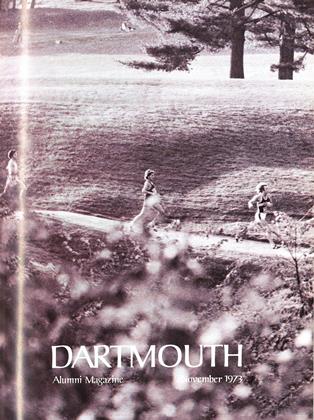QUICK GUIDE TO CHEESE. HOW TO BUY CHEESE HOW TO KEEP CHEESE HOW TO SERVE CHEESE HOW TO SELECT CHEESE.
November 1973 John Hurd '21QUICK GUIDE TO CHEESE. HOW TO BUY CHEESE HOW TO KEEP CHEESE HOW TO SERVE CHEESE HOW TO SELECT CHEESE. John Hurd '21 November 1973
By Robert Jay Misch '25. Drawingsby Robert Psotto. Garden City, New York:Doubleday & Company, Inc., 1973. 104 pp.$3.50.
Your passion for soda pop pacified, you may now preen yourself as a proper Oenophile (a wine lover). Expansion of vinous horizons being then appropriate, you may promptly explore the exotic worlds of Pecorino, Picodon, Port Salut, and Provolone. In brief, you may wish to pride yourself as a Turophile (a cheese lover). Let Mr. Misch guide your nose and tongue beyond the well known hards (Cheddar, Stilton, Cheshire, Gloucester, Wiltshire, and Gorgonzola) and the well known softs (Brie, Neufchatel, Camembert, and Limburg). The whole world is his cheese. He loves to talk about colors, body, texture, and the subtle nuances of flavor. His alphabetical glossary, world-wide, runs to nearly 300 items. He furnishes you with recipes for Appetizers, Luncheons, Pizzas, Soups, Eggs, Pastas, Accompaniments for the Main Course, Fondues, Sauces, and Desserts.
For incipient Turophiles, he lauds a spirit of adventure. Seek out specialty and ethnic shops. France alone has 325 varieties. If sampling is permitted, taste soft cheese by pressing it with full tongue and hard with only the tip. At a meal, offer at least four very different kinds on a large board with plenty of space, no overlap. Serve cheese not with salad and not after dessert but after the entree and before dessert. Thus it does not ignominiously compete with salad dressing and does not fight against sweetness.
DON'TS. Don't be so provincial as to make good the French saying, "Americans eat only with their eyes." That is, don't get carried away with the pretty look and slick packaging. Don't become fainthearted when Mr. Misch tells you that cheese may be made from the milk of reindeer, mares, buffaloes, camels, and asses. Don't freeze Camembert, and don't take Brie and Camembert on picnics, for they don't travel well. Don't take cheese out of your icechest for immediate use. Let it warm up first, like red wine. Don't scoop out bits of Stilton, "England's finest," or douse it with brandy. Cut off what you need and wrap the rest in a damp towel. Don't serve cheese with champagne or with drinks before a meal.
Mr. Misch praises Colby, "a delectable Vermont cheese - kissin' cousin of Cheddar but moister and not so hard." About it and Brie he writes lyrically: " ... the sensuous taste of a brie oozing lusciousness, or of a crumbly, sharp-mild Colby, smelling of clover and grass and conjuring up pictures of hot apple pie."
And he has the eye of a connoisseur for women He speculates whether Queen Nefertite, 14th century, B.C., perhaps the most dramatically real of all the great beauties of the past, may not have been well nourished on cheese. He quotes Brill Savarin (1775-1826), the expert on food and cooking, "A meal without cheese is like a lovely woman who has lost an eye." About higher human values an unnamed Frenchman observes with authentic Gallic insight: "Pity the poor girl who has not in her life learned to know love, wine, truffles, music - and cheese. She is not yet ready for marriage."
 View Full Issue
View Full Issue
More From This Issue
-
 Feature
FeaturemAgnA CARTA: Seventh Crisis of John Plantagenet
November 1973 By CHARLES T. WOOD -
 Feature
FeatureThe Quality of Life: YOUR MOVE
November 1973 By ROBERT E. HUKE'48 -
 Feature
FeatureA PORTFOLIO OF THE Dartmouth Cemetery
November 1973 By ADRIAN BOUCHARD -
 Article
ArticleBig Green Teams
November 1973 By JACK DEGANGE -
 Article
ArticleEditor, Banker, Artist, Engineer, Physicist Dartmouth's Post-War Refugee Students 25 Years Later
November 1973 By HARRIET GUNDERSEN -
 Class Notes
Class Notes1935
November 1973 By RICHARD K. MONTG.OMERY, C. HALL COLTON
John Hurd '21
-
 Books
BooksALL THE BEST IN THE SOUTH PACIFIC.
June 1961 By JOHN HURD '21 -
 Books
BooksTHIRTY-ONE SONNETS.
OCTOBER 1967 By JOHN HURD '21 -
 Books
BooksTHE PREVALENCE OF NONSENSE.
NOVEMBER 1967 By JOHN HURD '21 -
 Books
BooksFurther Mention
JANUARY 1972 By JOHN HURD '21 -
 Article
Article1972 Course Guide
JANUARY 1973 By JOHN HURD '21 -
 Books
BooksOHIO AN ARCHITECTURAL PORTRAIT
October 1973 By JOHN HURD '21
Books
-
 Books
BooksAlumni Articles
MARCH 1967 -
 Books
BooksBEAU-POIL AU MAROC
June 1940 By F. Cudworth Flint -
 Books
BooksNATURE LOVER'S TREASURY.
May 1948 By Herbert F.West '22. -
 Books
BooksGUIDANCE IN CATHOLIC COLLEGES AND UNIVERSITIES. Edited
October 1949 By Howard F. Dunham '11 -
 Books
BooksTRADEMARK PROBLEMS AND HOW TO AVOID THEM.
JULY 1973 By KENNETH R. DAVIS -
 Books
BooksLooking Back
April 1979 By R. H. R.

